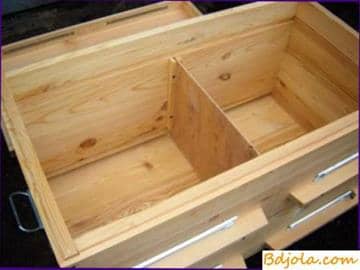
There are also horizontal hives – beds. They are similar to long boxes or chests. There are 16-20, and sometimes 24 frames with the size of 435×300 mm. The nest of bees is expanded in it not vertically, as in a multihull hive, but horizontally. The 16-frame lounger is designed for one family, and 20 and 24-frame lounges are for two. The volume of a lounger allows to grow families much more strongly, than in small-sized 12-frame.
Working with a lounger is not difficult. He therefore attracts beginner beekeepers. The bottom is nailed tight. Internal dimensions of the lounger: height 390, width 450 mm, length depends on the number of frames. In a 20-hive beehive, for example, the distance between the side walls is 790 mm, in the 18-frame hive is 715. At this distance, a partition is provided that separates one family from the other. In the sun lounger there are two lower and two upper ones. They are located on opposite sides – in the front and rear walls. There are one or two stores.
The ceiling is collapsible, the boards are covered with 3-4 frames. The roof is flat, level with the walls of the case, it is held by the outer folds, as in the 12-frame hive.
Young beekeepers are better off having a different hive, even an indiscriminate deck, in the school apiary. Then you can better understand the bees and their instincts, in the course of practice, make sure which beehive is more convenient and simpler.
Although they say that the beehive does not wear honey and that the bees can be driven even in a box from under the nails, this can not be accepted. After all, what a hive is, so is the care system. In one hive, it is easier to grow a strong family, in another it is more difficult; in one you can keep the working capacity of bees, in another it is more difficult or impossible.
Как хранить рамки. Весы для улья.
Hives, inventory